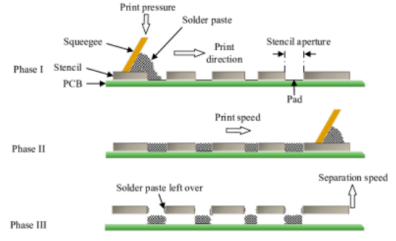What Role does Solder Paste Viscosity Play in Packaging
What Role does Solder Paste Viscosity Play in Packaging
One of the important processes of electronic packaging is chip fixing, which is required to form an electrical connection between the chips and the pads. Various methods can be taken to fix the chips on the pads. Reflow soldering is the following process to complete the metallurgical connection. Solder paste is an excellent bonding material, which is deposited on the pads by printing, dispensing, and other processes. Then the chips are fixed in a specific position by the tackiness of the solder paste. Taking the printing process as an example, the solder paste needs to be released to the pads through a stencil, so the viscosity of the solder paste needs special attention. The viscosity determines whether the solder paste can pass through the stencil apertures smoothly. The viscosity range of printing solder paste is about 100-200Pa.s, which is required to adjust for different scenarios.

Figure 1. Schematic diagram of solder paste printing.
In the process of solder paste preparation, the flux solvent can make the components of the solder paste evenly distributed. Meanwhile, it can adjust the viscosity of the solder paste. Solvents are usually made of alcohols (such as ethanol and ethylene glycol), lipids (ethyl acetate), etc. Since the solvent is volatile at high temperatures, the specific gravity of solid matter will increase, so it needs to be stored in a refrigerator at 0-10 °C when the solder paste is not used.
Solder paste is a shear-thinning material that becomes less viscous when subjected to shear forces. When the shear force disappeared, the viscosity returned to normal. Therefore, when the squeegee is used for solder paste printing, the viscosity of the solder paste is minimized due to the shear force when passing through the mesh. The fluidity of the solder paste should be excellent, allowing the solder paste to deposit on the pads. Since the printing process usually takes several hours, the solder paste viscosity needs to remain stable when operating. When the ambient temperature is too high, the solvent components of the solder paste flux will evaporate. Hence, the solder paste will become dry, and the viscosity will decrease. The decrease in solder viscosity makes it difficult to form an excellent shape, and the probability of thermal slump significantly increases during the heating process.

Figure 2. Solder paste viscosity change during printing.
In order to maintain an excellent viscosity, solder paste needs to rewarm for 2-3 hours before use so that the solder temperature is the same as the room temperature, and it needs to be stirred for 2-5 minutes. Insufficient rewarming will cause the solder paste to absorb moisture and reduce the viscosity. Stirring can mix the solder alloy and flux evenly and increase the fluidity. After stirring, the solder paste can reduce delamination and make the viscosity distribution more uniform. The ratio of alloy solder powder to flux affects solder paste viscosity. Under a fixed mass, the viscosity of the solder paste is inversely proportional to the proportion of alloy powder. In addition, the workshop temperature and humidity should be controlled at about 25°C and 50%RH, respectively.
Fitech is a world-leading provider of microelectronics and semiconductor packaging materials solutions. Fitech’s regular solder paste, epoxy solder paste and other products have outstanding wettability, uniform powder particles, and high post-soldering reliability. Welcome to the official website for more information.


















 Back to list
Back to list



